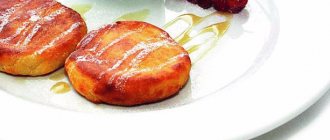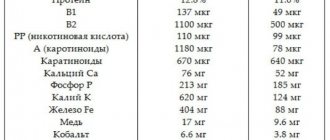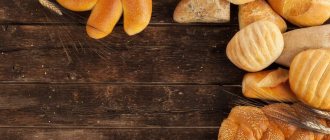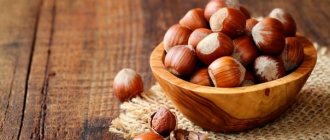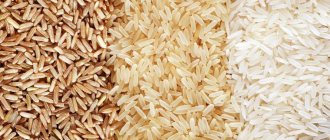The first consumers of oatmeal were not the British; horses were the first to appreciate the usefulness of oats. Thanks to these grains, they can withstand heavy loads and have excellent health. Why do people still have to prove how healing oatmeal is? This article will talk about what vitamins oatmeal contains and how it is beneficial for the body.
Oats are a food cereal crop. Oat flakes are eaten, they are peeled and steamed. All the beneficial substances and vitamins contained in oatmeal are retained in it even after heat treatment. Oats contain complex carbohydrates, thereby being a powerful source of energy.
One bowl of oatmeal contains a quarter of a person’s daily requirement for fiber.
Oatmeal is rich in compounds and tocopherol (E). They nourish and heal the skin, maintain the balance of the nervous system. The table shows which vitamins predominate in oatmeal:
| Name | mg per 100 g |
| 0,5 | |
| 0,1 | |
| 1,1 | |
| 94 | |
| 0,9 | |
| 0,27 | |
| 0,029 | |
| 3,4 |
Scientists believe that consuming oatmeal has a beneficial effect on human life expectancy. You can endlessly joke about the selfless love of the British for oatmeal, but the statistics are inexorable. Residents of this country live on average 15 years longer than other Europeans.
Oatmeal includes the following micro- and macroelements:
A small serving of oatmeal contains:
- daily intake of silicon
, which is responsible for the absorption of calcium and contributes to the normal functioning of the brain; - the same level of manganese
, without which thiamine, copper, and iron cannot be fully absorbed; - a third of the daily norm of phosphorus
, which strengthens bone tissue; - a quarter of iron
responsible for hemoglobin levels; - the same amount of magnesium
, which improves the condition of the nervous system and protects against stress.
Benefits of oatmeal
The products have many advantages:
- Oatmeal coats the inner surface of the stomach, thereby easing the painful symptoms of gastritis and ulcers.
- The fiber contained in oatmeal normalizes the activity of the stomach and intestines.
- Oats contain beta-glucan, which helps lower cholesterol.
- The low glycemic index allows rolled oats to be completely absorbed, while having a low calorie content.
- Thanks to its vitamin composition, oatmeal gives you a boost of energy and strength for the whole day.
- The substances included in the composition prevent osteoporosis and protect bones and teeth from destruction.
What does energy value depend on?
The cooking method does not greatly affect how many dangerous calories are found in boiled oatmeal. The energy value is influenced by the following factors:
- what initial product will be used - cereals, grains or packaged crushed and processed flakes;
- what the porridge will be cooked on. Milk increases the calorie content of the finished dish by 3 times;
- what other ingredients will you put in the oatmeal. Sugar, butter and honey will reduce the dietary value of this product.
In what form is oatmeal consumed?
Oatmeal porridge contains only 15 kcal more than porridge cooked in water. The nutritional value makes you feel full quickly.
Nutritionists recommend using oatmeal jelly for weight loss. Its mild effect and cleansing properties are gentle on the stomach and remove all excess.
This recipe is widely used in cosmetology. Crushed oatmeal is poured with warm water and infused. Then this paste is used as a mask on the face and décolleté. This mask acts as a natural scrub, cleanses pores and makes the skin elastic.
Bran
Some people still regard bran as a product not worthy of attention. However, oat bran consists of 90% active ingredients and is superior in potassium content. Fiber in bran prevents dysbiosis.
The value of oatmeal cookies is as follows:
- baking takes less time than other types of cookies;
- most of the nutrients are retained;
- cookies are famous for their high taste.
Oatmeal is a unique food product of its kind. With a high calorie content, oatmeal is considered perhaps the best food for losing weight and cleansing the stomach and intestines.
The British prefer to have healthy oatmeal with water for breakfast, perhaps because the average life expectancy in England is 70-75 years, which is 10-15 years higher than statistics throughout Europe.
It is interesting that the English began to eat oatmeal in the morning, following the Scots, although in the middle of the 17th century they spoke very negatively about people who ate “horse feed”. One has only to read Samuel Johnson's well-known English dictionary to understand the emphasis placed on this fact. The writer James Boswell responded to Johnson’s taunts and disdainful attitude toward the Scots’ diet: “It is thanks to oats that excellent horses are raised in England, and wonderful healthy people live in Scotland.” And this is true, because the benefits of oatmeal are recognized by nutritionists around the world. But how and when should you eat it, and how does washing with this product affect the skin? What are the contraindications for regular use?
Negative effects on the body
Although oatmeal can be eaten even by allergy sufferers, since it contains the substance biotin, there are other reasons why cereal can be harmful. This rare pathology is called celiac disease - an allergy to grains. Otherwise, oatmeal cannot harm a person if consumed in reasonable quantities and not limiting the diet to it alone. Cereals contain acid, which helps wash calcium out of the body if its content in the body is higher than normal.
Nutritional properties
Oats are a valuable food grain that has been successfully used in Rus' for many millennia in cooking. And its main purpose is porridge. The diet includes peeled and steamed oat flakes. Their value is due to the presence of a mass of nutrients and substances in them. The nutritional value of oats is completely preserved, because this cereal is one of those few that, even after heat treatment, do not lose their beneficial properties.
Oatmeal, the benefits and harms of which have been discussed for decades, is flakes that are processed and flattened into thin plates, unlike grains, they are cooked much faster and are used in the preparation of various dishes. The most famous of them is oatmeal (porridge based on oatmeal). The benefits of oatmeal have been scientifically proven and lie in its vitamin and nutritional value; there are practically no contraindications.
The nutritional value
The benefit of oatmeal lies in its rich fiber content, which is so necessary for humans. The energy value per 100 grams of product is 320 kcal. Moreover, these properties do not change whether you use bran, cookies, decoction, jelly or oatmeal.
Composition of the product:
Vitamins
It should be noted that vitamins are, first of all, group PP, C, E, carotene, choline, the entire vitamin B group. Vitamins saturate and nourish the skin (decoction and washing in the morning), activate hair and nail growth (bran, rolled oats, jelly). It is known that regular consumption and benefits of oatmeal, the recipe for which is known to everyone, has a beneficial effect on the central nervous system, calms, and relieves stress.
What vitamins, see the table:
| per 100 grams of product | vitamin content mg |
| Vitamin B1 | 0.5 |
| Vitamin B2 | 0.1 |
| Vitamin B3 | 1.1 |
| Vitamin B4 | 94 |
| Vitamin B5 | 0.9 |
| Vitamin B6 | 0.27 |
| Vitamin B9 | 0.0029 |
| Vitamin E | 3.4 |
Minerals
In addition, oatmeal contains minerals, the main components of which are phosphorus, magnesium, sulfur, sodium, and potassium. Research shows that when interacting with each other, this set of minerals serves as an indispensable assistant in the treatment of cardiovascular diseases, strengthening and growth of muscle and bone tissue. The mineral component is supplemented by zinc, nickel, iron, molybdenum and copper. These elements accelerate cell growth and have a beneficial effect on the condition of the skin, so the benefits of oatmeal play a huge role in women’s nutrition. In addition, you can eat not only porridge; for variety, the diet includes bran, jelly and cookies, rolled oats. Oat flour is ideal for dietary nutrition - pancakes, cookies, bread.
Minerals and vitamins in oatmeal give it healing properties, and bran (fiber) and dietary fiber (rolled oatmeal, broth) make it possible to use it as an antioxidant. The product improves the functioning of the stomach and intestines, removes harmful substances and toxins from the body, cleanses vital organs - liver, pancreas.
Minerals see table:
Beneficial features
One of the popular and famous dishes made from oats and oat flakes is porridge. You can take it for breakfast (rolled oats), which makes it possible to saturate the human body and provide it with energy for the whole day. The same thing will happen to your skin if you include cleansing in your morning routine. The recipe for preparing a decoction to cleanse the skin is simple, and washing will not take much time.
Hercules
Oatmeal (rolled oatmeal) cooked in milk contains 100 kcal per 100 grams, and in water - 85. Thus, the benefits of oatmeal in the morning are obvious - due to the high carbohydrate content, the body receives a boost of energy, thanks to the low glycemic index of oatmeal (or bran) It is well absorbed by the body, and the calorie content of the product remains minimal. An excellent addition to the main breakfast can be cooked jelly, cookies for tea (oatmeal is very valuable in composition). The recipe for preparing the dishes is not complicated, since the main ingredient is flour or broth, and therefore the cookies are baked for half an hour.
Oatmeal, and therefore jelly or cookies made from it, is recommended as the main product in the diet of people working in hazardous chemical industries. Research has proven the benefits of oatmeal in case of severe toxin poisoning.
For washing
Oatmeal has also proven itself excellent in cosmetology. Washing and the benefits of washing with oatmeal lie in its action as a natural scrub that cleanses pores and smoothes the skin. It is recommended to do the procedure at night. The flakes are first ground with a blender or coffee grinder to make flour, poured with lukewarm water and this paste (or jelly) is applied to the face. Keep the mask for 5-10 minutes, no more, and then wash off. Vitamins help cleanse and smooth the skin. Oatmeal is sold today in any supermarket, and the recipe is not complicated, so washing can be done every day.
When choosing a product, focus on a manufacturer you know. For example, the well-known Hercules oatmeal, just like oatmeal, is very healthy and nutritious. They are used in the production of muesli and have proven themselves as an ingredient for making cookies at home. The recipe is simple; in addition to flour, it contains broth and 1-2 eggs, but the benefits of such a dessert are great.
Oat bran
In dietary and therapeutic nutrition, it is also recommended to take oat bran. And although many people look at this product as waste after processing wheat, in Rus' for a long time only peeled flour was used for baking bread, wheat flour of the highest grades was used only for holiday baking and cookies.
The benefit of oat bran lies in the fact that its composition consists of 90% only active components, and the potassium content is several times higher than its content in raw potatoes. In addition, bran is a fiber that has a beneficial effect on the stomach and intestines, improves microflora and prevents diseases such as dysbiosis. To prevent diseases of the gastrointestinal tract, a decoction is used, the recipe for which is simple. It is recommended to take the decoction regularly, and also start washing with it.
Kissel
The recipe for oatmeal jelly, healthy and recommended for weight loss, is simple - you just need to pour cool purified or boiled water over the oatmeal, add a small slice of rye bread, cover with a lid and leave in a warm place overnight. The jelly is ready when it has a pleasant sour smell. The product must be strained before use.
Kvass
Another product that is also popular in folk medicine is oat kvass. This healthy drink has the same healing properties as oatmeal. The benefit of oat kvass also lies in the fact that it stabilizes blood sugar in people suffering from diabetes. In addition, children drink it with pleasure. Often refusing to eat oatmeal for breakfast, they receive the same vitamins, but with greater pleasure.
Modern technologies have made it possible today to use such wonderful household appliances in the kitchen as multicookers and bread makers. People, wanting to get away from low-quality food products, strive to produce as much food as possible at home. Try baking bread from oatmeal - it is both healthy and very tasty if the recipe is reliable.
The benefits of oats and oatmeal are obvious, but when cooking, do not overdo it by adding all kinds of additives to the dish in the form of fruits, sugar, or milk if these products are contraindicated for you.
Oatmeal is, without a doubt, one of the healthiest dietary foods. Oatmeal is indicated for consumption at any age; at each stage it solves certain problems. In childhood, it is needed to form a correct and strong bone skeleton and prevent anemia; in adulthood, it helps to keep the heart and blood vessels healthy, and get rid of bad cholesterol. Throughout her life, she is an ambulance for diseases of the gastrointestinal tract, a source of beauty and vigor.
Sometimes it’s not a colorful description, but dry numbers that can say much more. The exact content of a particular substance in a product clearly demonstrates its benefit or harm. To understand and appreciate the benefits of oatmeal, let's look at its calorie content and composition, what fats, proteins, carbohydrates and microelements it contains.
How many calories are in 100g of oatmeal?
The calorie content of oatmeal depends on the type of cereal and the method of preparation. 100 grams of porridge, prepared according to all the rules (with milk, sugar, butter, salt) contains about 350 calories. But 100 grams of pure oatmeal contains only 92-102 calories. Therefore, you need to use oatmeal for weight loss carefully and without excess.
100 grams of oatmeal contain proteins - 3.2 g, fats - 4.1 g, carbohydrates - 14.2 g. Its glycemic index is 85.
Its chemical and biological composition includes many substances important for human health. Oatmeal contains in fairly large quantities such macro- and microelements as: magnesium, phosphorus, chromium, iron, manganese, iodine, fluorine, zinc, cobalt.
Oatmeal is also rich in vitamins. Of course, these are: B1, B2, B6, as well as vitamins A, E, PP, K.
Oatmeal is the best source of fiber and complex carbohydrates
. Since oatmeal contains a large amount of protein and fiber, it perfectly stimulates metabolism and helps muscle mass grow and develop. For example, a standard serving of oatmeal contains 14 daily fiber requirements, and 3/4 cup of rolled oats contains the entire daily fiber requirement.
How to store
You can store oatmeal in different ways. Many people use cellophane bags for these purposes; they have a shelf life of 1 year. Can be stored in cardboard packaging for no more than 4 months.
The table contains methods for storing this cereal.
| Container type | pros | Minuses |
| Metal | Looks high quality and stylish | Rust forms over time |
| Plastic | Very light, do not put a strong load on shelves and cabinets | Need to change jars frequently |
| Ceramic | Beautiful design, roomy, low cost | The container is heavy |
| Glass | Stylish look, light, roomy, inexpensive | None |
Oatmeal is a valuable product that must be included in the menu of adults and children. It has a beneficial effect on health.
But it is still necessary to use it correctly. You shouldn’t eat it all the time; it’s better to alternate it with other cereals. The best time to use it is in the morning, namely breakfast.
This section presents the calorie content of oatmeal in various preparation options (with additives, instant porridge or porridge in bags), as well as the content of proteins, fats and carbohydrates. All data is provided per 100 grams of the finished product. To find out the content of BZHUK in a serving (plate) or in any other volume (for example, 30 or 40 grams), enter the required amount of product into the calculator.
1 standard serving of food (plate) = 250 grams.
Harm of oatmeal
Oatmeal also contains a substance called gluten. Literally translated as glue, in fact it is a protein and it is thanks to it that oatmeal porridge has its special consistency. Most people benefit from this protein, but there are diseases and conditions for which gluten is contraindicated. Celiac disease is a genetic predisposition to intolerance to this substance; in this case, eating oatmeal is prohibited.
Calories, kcal:
Proteins, g:
Carbohydrates, g:
Oat flakes are produced by steaming and flattening, while partially preserving the cereal shell. Oatmeal varies in degree of purification, steaming time and thickness; the thinnest flakes cook the fastest, but they have practically no beneficial properties. Oatmeal has a light brown or golden color with darker veins and a light cereal aroma.
Porridge made from oatmeal is a traditional breakfast not only in England, but almost everywhere. Oatmeal cooks quickly, keeps you feeling full for a long time, gives you vigor and fills the body with energy.
Calorie content of oatmeal
The calorie content of oatmeal is 366 kcal per 100 grams of product.
Oatmeal contains a large amount of coarse dietary fiber, which, when it enters the stomach, absorbs liquid, increases in size several times, and, passing through the intestines, takes with it unnecessary waste and toxins, thereby cleansing the body. Fiber normalizes intestinal motility, stimulates digestive processes and is a preventative against constipation. Oatmeal contains , without which the energy necessary for the functioning of all body systems cannot be produced. The product helps to significantly reduce blood cholesterol levels and reduces the risk of cholesterol plaques on the walls of blood vessels. Including oatmeal in the diet prevents stroke, heart attack and atherosclerosis, increases the body’s protective properties, and normalizes the activity of the nervous system.
Harm of oatmeal
Oatmeal for weight loss
Despite the fairly high calorie content of the product, it will not harm even the slenderest figure (calorizator). The uniqueness of oatmeal lies in the fact that the product is easily digested, and the complex carbohydrates that make up oatmeal satiate for a long time, and the body retains the energy received. Regular consumption of oatmeal normalizes digestion, so the weight loss process goes faster.
Selection and storage of oatmeal
The healthiest oatmeal is considered to be one whose cooking time is at least 10-15 minutes, that is, those that have undergone minimal processing and retained all the beneficial properties of whole grains. If oatmeal is sold in transparent packaging, you should pay attention to the absence of flour and small parts of the flakes; these are signs that the flakes were often subjected to mechanical stress during transportation.
Oatmeal should be stored in a cardboard or glass container, tightly closed, away from light. The shelf life of oatmeal usually does not exceed 6 months, so when purchasing, you need to pay attention to the date of manufacture.
Oat flakes in cooking
The simplest use of oatmeal is to prepare porridge, the benefits of which have long been proven. It is best to cook oatmeal on, and, or add to the finished product. In addition, oatmeal is added to the dough for baked goods, cookies, muffins, and you can make pancakes and pancakes from oatmeal. Oatmeal can be used as a substitute for breading for fish, vegetables or cutlets.
For more information about oatmeal and other types of oatmeal, watch the video “Real Food. Oats" TV show "Live Healthy".
Especially for Copying this article in whole or in part is prohibited.
Nutritional value per 100 grams of oat flakes:
- Carbohydrates – 66.27 g
- Proteins – 16.89 g
- Fat – 6.9 g
Energy value in 100 grams of oat flakes:
- 389 kcal
Carbohydrates in oatmeal
Monosaccharides:
- Glucose – 0 g
- Fructose – 0 g
Disaccharides:
- Sucrose – 0 g
Polysaccharides:
- Starch – 55.7 g
Proteins in oatmeal
Essential amino acids:
- Valine – 0.937 g
- Histidine – 0.405 g
- Glutamine – 3.712 g
- Isoleucine – 0.694 g
- Leucine – 1.284 g
- Lysine – 0.701 g
- Methionine – 0.312 g
- Threonine – 0.575 g
- Tryptophan – 0.234 g
- Phenylalanine – 0.895 g
Essential amino acids:
- Alanine – 0.881 g
- Arginine – 1.192 g
- Asparagine – 1.448 g
- Glycine – 0.841 g
- Proline – 0.934 g
- Serine – 0.750 g
Conditionally essential amino acids:
- Tyrosine – 0.573 g
- Cystine – 0.408 g
Fats in oatmeal
- Saturated
fatty acids – 1.217 g - Monounsaturated
fatty acids – 2.178 g - Polyunsaturated
fatty acids – 2.535 g - Cholesterol – 0 mg
Minerals in 100 grams of oatmeal:
- Calcium – 54 mg
- Iron – 4.72 mg
- Magnesium – 177 mg
- Phosphorus – 523 mg
- Potassium – 429 mg
- Sodium – 2 mg
- Zinc – 3.97 mg
- Copper – 0.626 mg
- Manganese – 4.916 mg
Vitamins in 100 grams of oatmeal:
- Ascorbic acid ( Vitamin C
) – 0 mg - Thiamine ( Vitamin B1
) – 0.763 mg - Riboflavin ( Vitamin B2
) – 0.139 mg - Niacin ( Vitamin B3
or
Vitamin PP
) – 0.961 mg - Pantothenic acid ( Vitamin B5
) – 1.349 mg - Pyridoxine ( Vitamin B6
) – 0.119 mg - Folacin ( Vitamin B9
or folic acid) – 56 mcg - Choline ( Vitamin B4
) – 0 mg - Retinol ( Vitamin A
) – 0 mcg - Tocopherol ( Vitamin E
) – 0 mg
The benefits of oatmeal (oatmeal)
Energy benefits of oatmeal:
100 grams of oatmeal contains about 55.7 grams of digestible carbohydrates. This means that by eating a 100 gram portion, your body receives 222.8 kcal, which will go directly to providing the body with energy. Moreover, all these carbohydrates are represented by starch. Starch is a complex carbohydrate, digested gradually, enters the blood slowly, muscles and liver store it in the form of glycogen chains, after which, if necessary, it is used by the body for a long time.
Oatmeal provides the body with energy for a long time.
Construction benefits of oatmeal:
100 grams of oatmeal contains 16.9 grams of protein. The amino acid composition is complete, but oatmeal is a product of plant origin, which means the protein will be poorly absorbed and most of the essential amino acids simply will not be absorbed by our body.
Oatmeal is a poor source of protein, so it does not provide any particular building benefits for our body.
Benefits of oatmeal for the digestive system:
100 grams of oatmeal contains 10.6 grams of dietary fiber (fiber), which is equal to 30% of the daily requirement for an adult. Dietary fiber helps digest food and remove toxins.
Oatmeal is very useful to include in your diet, as you help your digestive system and rid your intestines of toxins that accumulate during the day and during sleep.
Fat benefits of oatmeal:
100 grams of oatmeal contains about 5 grams of fully digestible fats, which will be directly used by our body for protective and energy functions. Thanks to the fats in oatmeal, minerals from the oatmeal itself and other products incoming at this moment can enter directly into the blood and be subsequently used by our body for its intended purpose.
There are few saturated fats, which means the fats from oatmeal will not harm your body!
Mineral benefits of oatmeal:
Let's see how much a 100 gram serving of oatmeal satisfies the body's daily need for the most basic and essential minerals:
- Calcium – 6.75%
- Iron – 31.47%
- Magnesium – 44.25%
- Phosphorus – 34.87%
- Potassium – 10.73%
- Sodium – 0.05%
- Zinc – 26.47%
- Copper – 31.3%
- Manganese – 163.87%
As we can see, oatmeal is a very good source of the minerals we need. This product can rightfully be considered a source of the following minerals:
- Iron
- Magnesium
- Phosphorus
- Manganese
Vitamin benefits of oatmeal:
Let's see how much 100 grams of oatmeal per day satisfies the body's daily need for vitamins:
- Ascorbic acid ( Vitamin C
) – 0% - Thiamine ( Vitamin B1
) – 38.15% - Riboflavin ( Vitamin B2
) – 6.95% - Niacin ( Vitamin B3
or
Vitamin PP
) – 6.41% - Pantothenic acid ( Vitamin B5
) – 13.49% - Pyridoxine ( Vitamin B6
) – 5.95% - Folacin ( Vitamin B9
or folic acid) – 3.73% - Choline ( Vitamin B4
) – 0% - Retinol ( Vitamin A
) – 0% - Tocopherol ( Vitamin E
) – 0%
- Vitamin B1
- Vitamin B5
1. Buckwheat
Photo source: pxhere.com
Buckwheat contains approximately 12.6% protein (and it is considered easily digestible). This product is also rich in magnesium, copper, a whole list of B vitamins, potassium, manganese and iodine. The fat content is only 1%.
Eating buckwheat helps increase hemoglobin levels, reduce the concentration of bad cholesterol in the blood, improve the functioning of the gastrointestinal tract, eliminate swelling and strengthen the body's resistance to various infections. This product also helps maintain the beauty of skin, nails and hair.
Note! When cooked, all cereals swell, so the percentages of protein and other substances undergo significant changes.
